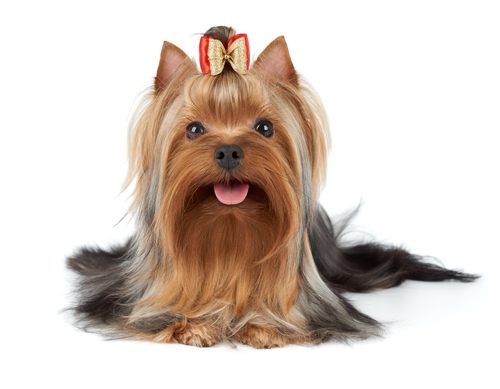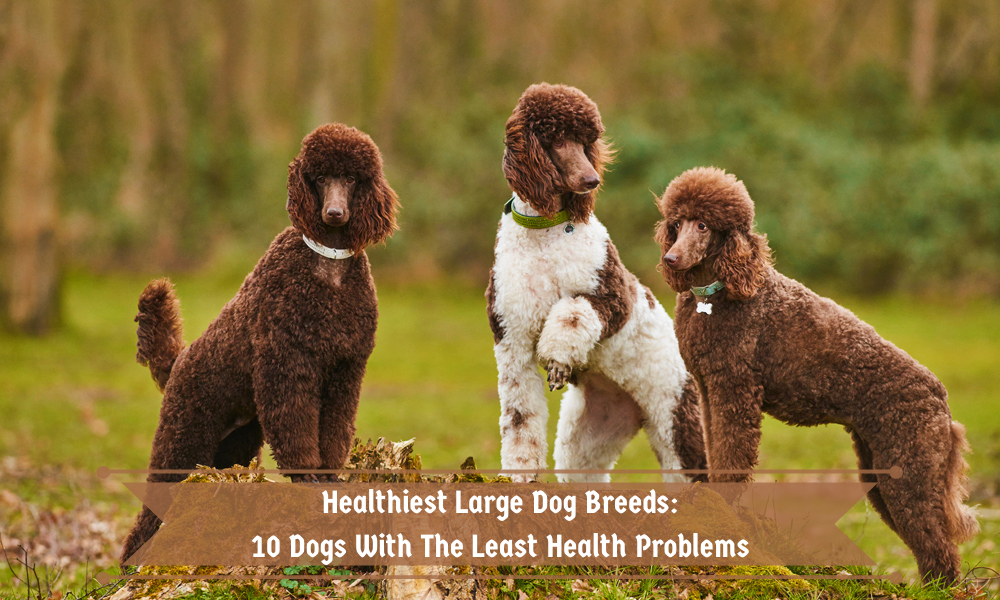
A lot of people have the misconception that large dog breeds are unhealthy and don’t live very long. But that’s not true! There are a lot of big, lovable dogs out there with minimal health problems that live for a decade or longer. Let’s take a look at the healthiest large dog breeds and what makes each so special.
Contents
1. German Shorthaired Pointer
The German Shorthaired Terrier weighs between 45 and 70 pounds and, although it’s a big dog, it’s one of the smallest on our list. This is a versatile breed that was bred for hunting but is also a trusting and loyal companion.
German Shorthaired Pointers need a lot of exercise to burn off energy – about an hour or two every day – and they’re really smart so they need adequate mental stimulation, too. When they aren’t exercised or challenged enough, they can be destructive, but, if you keep them active and engaged, they’re usually well-behaved.
This pup loves to be outdoors. It makes a great hunting companion and would love to join you on hikes through the woods. German Shorthaired Pointers are a bit rambunctious so, while they’re great with kids, they may be a bit too much for toddlers and infants. They love to be with their people and get sad if they’re left at home alone for too long.
There are a few health conditions that are common to the breed, including hip dysplasia, certain types of cancer, bloat, and a clotting disorder called Von Willebrand’s Disease. The average lifespan for these energetic pups is between 12 and 15 years.
2. German Shepherd
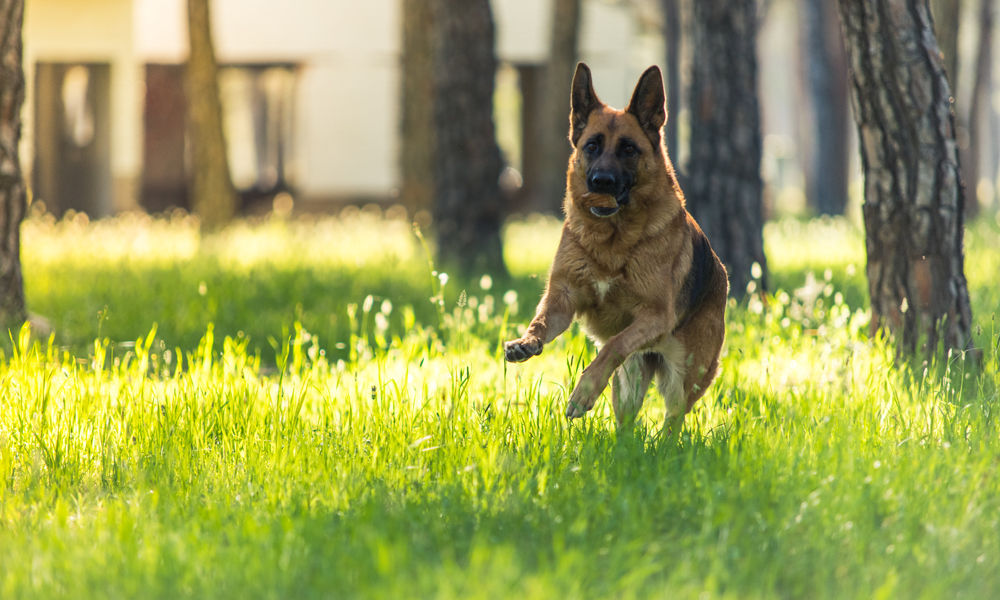
Source: canva.com
If you’re looking for a large, healthy breed that’s also active and fiercely intelligent, the German Shepherd might be a good match. They usually weigh between 75 and 95 pounds. One thing that’s important to keep in mind about this breed is that they have to be kept busy, both physically and mentally. They love to exercise, learn, and play.
German Shepherds form strong bonds with their families and do not like being alone for long periods of time. They can get anxious and bored which usually results in them being destructive by chewing, digging, or barking excessively.
The natural inclination of this large dog breed is to be suspicious of strangers which is why they make such good watchdogs, but this is also the reason why it’s so important to socialize them early. Expose your young German Shepherd to a variety of places, people, and experiences to make sure it gets used to being around new people and places.
This is a generally healthy breed that usually lives between 10 and 14 years. Common conditions affecting them are hip and elbow dysplasia, bloat, pancreatic insufficiency, allergies, and a disease of the spinal cord called degenerative myelopathy that disrupts communication from the hind legs to the brain.
3. Labrador Retriever
Labrador Retrievers are one of the most popular breeds around. They’re a big dog that usually weighs between 55 and 80 pounds and were bred for demanding physical tasks. This is a working breed so it has a lot of energy and needs about 30 to 60 minutes of intense exercise every day. Like most high-energy dogs, Labs become destructive when they don’t get enough exercise.
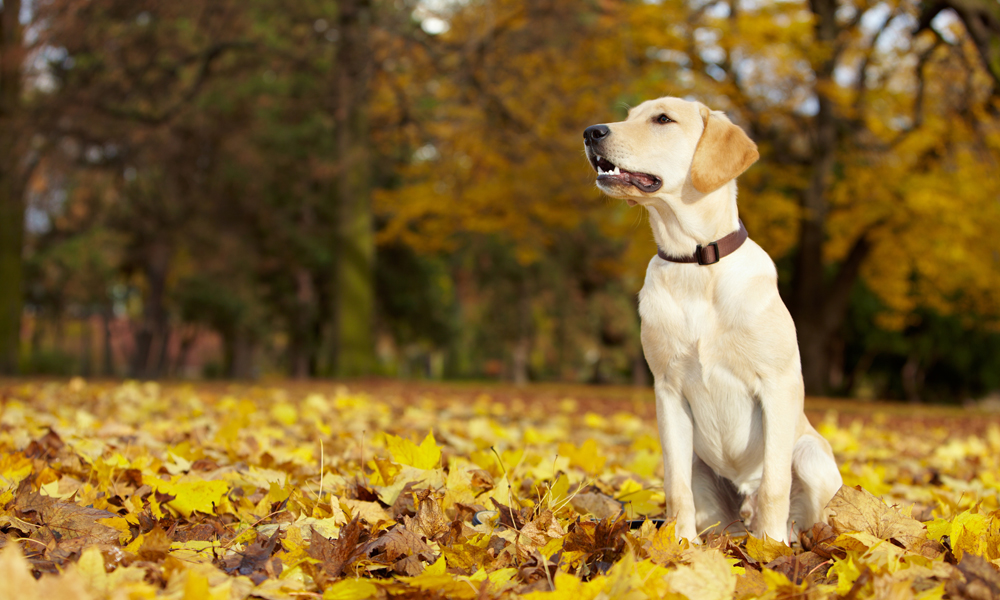
Source: canva.com
This is an intelligent breed so they’re relatively easy to train. Because they’re so lively, especially when they’re younger, obedience classes are usually a good idea. Labs love to eat so keeping their weight in check is important to keep them healthy. They will eat just about anything, including garbage and things that aren’t even food. Don’t overfeed them and, again, adequate exercise is really important.
Labs have a life expectancy of 10 to 12 years. They’re a healthy breed but there are a few conditions that they are prone to, including hip and elbow dysplasia, bloat, cataracts, progressional retinal atrophy, epilepsy, skin conditions, ear infections, heart defects, and joint issues.
4. Standard Poodle
The Standard Poodle is another big dog breed that’s healthy, active, and smart. They have big personalities, and if you don’t teach them otherwise, they think they’re in charge. Obedience training is essential to keeping your Standard Poodle active and engaged so they don’t get bored and find destructive ways to entertain themselves.
One of the things to consider about a Standard Poodle is they need regular grooming. You can learn to do it yourself or take them to the groomer every three to six weeks or so. While they’re one of the smaller breeds on our list, Standard Poodles weigh between 45 and 70 pounds.
This breed lives between 12 and 15 years which is pretty impressive for a large dog. There are a few conditions that some Standard Poodles will develop, including Addison’s disease, bloat, Cushing’s disease, epilepsy, hip dysplasia, hypothyroidism, patellar luxation, eye disorders, and Von Willebrand’s. One of the more serious problems Standard Poodles may develop is sebaceous adenitis which causes skin inflammation and hair loss. This condition is not deadly but can be uncomfortable for the dog and requires ongoing care and attention.
5. Australian Shepherd
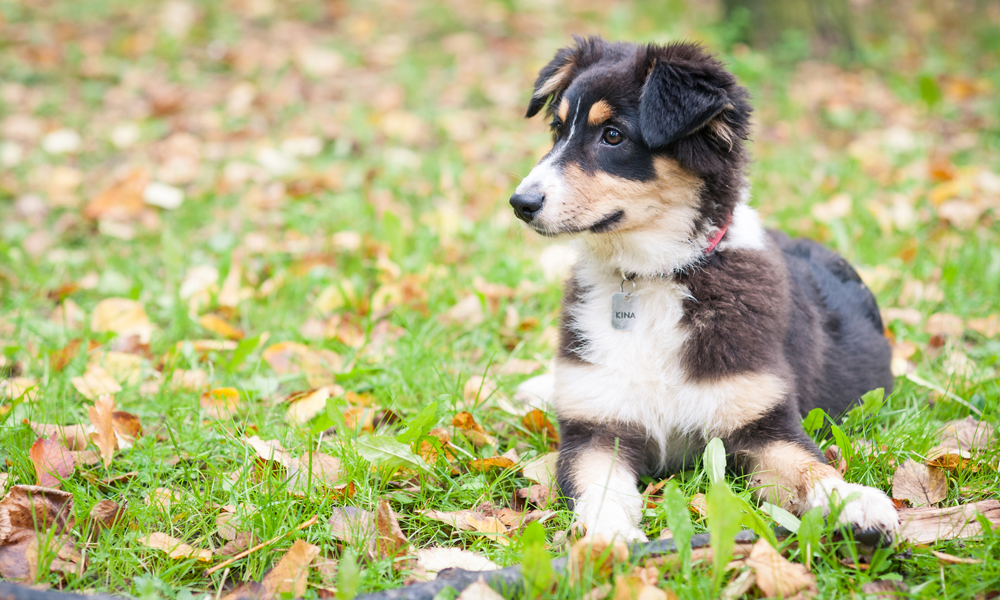
Source: canva.com
While they’re still considered a big breed, Australian Shepherds are one of the smaller dogs on our list, weighing between 40 and 65 pounds. These pups were bred to herd livestock and, though they’re great with families, they’re a working dog at heart. They love having a job to do and being involved in various sports and activities.
These dogs do especially well in a home where they are challenged to put their energy and intellect to good use. You have to actively keep them busy. This isn’t the dog to pick if you want a pup to cuddle up on the couch with you. A yard to run around in is ideal but where this breed really shines is in sporting and agility competitions. They also make great police, search and rescue, assistance, and guide dogs.
Australian Shepherds are generally healthy, but there are some conditions they’re at risk for, including hip and elbow dysplasia, deafness, epilepsy, various eye problems, allergies, hypothyroidism, cancer, and nasal solar dermatitis or Collie nose. Despite these risks, Australian Shepherds have an average lifespan of 12 to 15 years.
6. Alaskan Malamute
If you’re an experienced dog owner looking to welcome a new large dog to the family, consider an Alaskan Malamute. They weigh between 75 and 100 pounds and their unique blend of stubbornness and intelligence is hard to manage unless you have some experience training dogs.
Malamutes like to be in charge and will attempt to take control of your household. Every member of the family should be prepared to establish that the dog is not the leader of the pack to prevent it from trying to push them around.
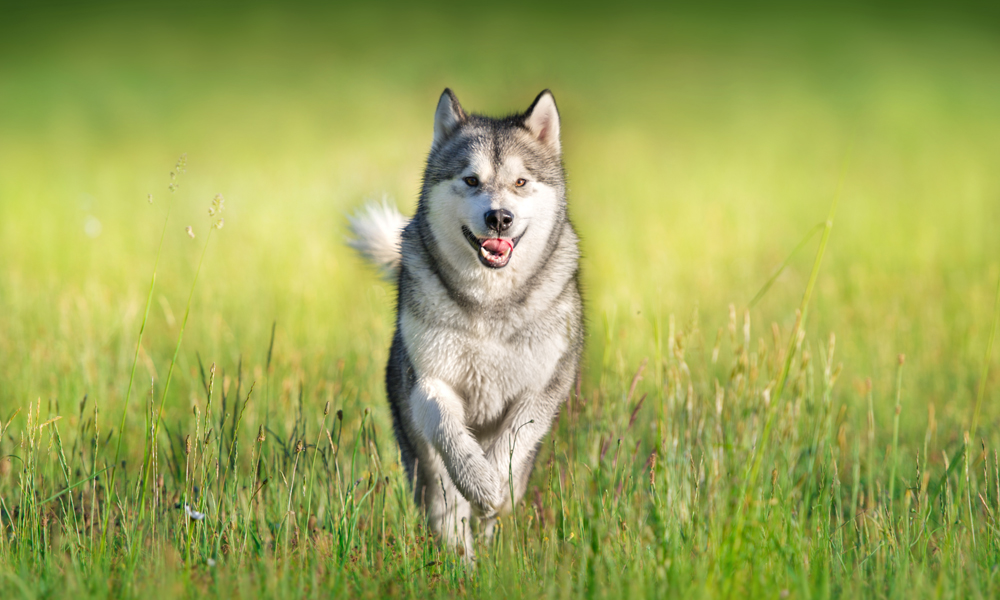
Source: canva.com
That said, with training and early socialization, they learn to get along with other animals and indoor pets. They’re high-energy dogs that require vigorous daily exercise but the hard work is worth it. These pack animals form a close bond with their family and are extremely loving and loyal.
This is a generally healthy breed but there are some health issues that they’re prone to developing, like cataracts, dwarfism, hip dysplasia, hypothyroidism, day blindness, and inherited polyneuropathy, which causes a lack of coordination and instability. The average lifespan for this big dog is 12 to 15 years.
7. Doberman
Doberman Pinschers are elegant, athletic dogs that have become one of the most widely recognized breeds around. Although they have a lean, muscular build, but they’re still considered a large breed and weigh between 60 and 80 pounds.
This breed has a fierce reputation, and while they do make excellent guard dogs, they’re also gentle and loving with their people. They’re protective of children in the home and are welcoming to guests as long as they are being treated kindly. Dobermans do not go seeking out trouble but they have no problem defending their families when necessary.
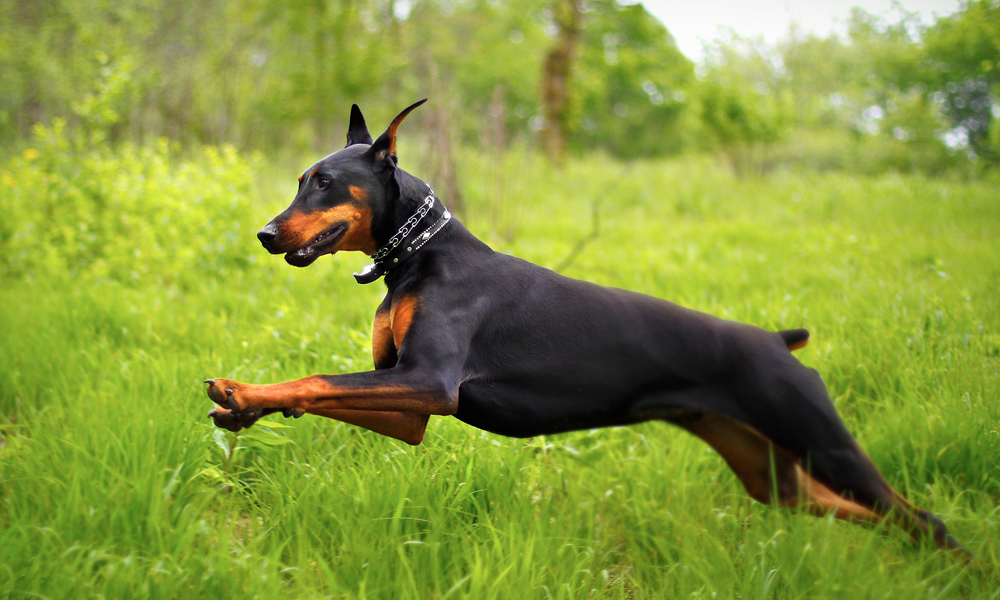
Source: canva.com
Because they are so athletic, they have a lot of energy to burn and need rigorous daily exercise, training, and socialization. They’re pretty healthy overall and have a life expectancy of 10 to 13 years but, like all breeds, there are a few conditions that they’re prone to. These include Von Willebrand’s Disease, hip dysplasia, hypothyroidism, cardiomyopathy, Wobblers Syndrome, albinism, narcolepsy, bloat, and eye diseases.
8. Rottweiler
Rottweilers are the biggest breed on our list weighing between 85 and 130 pounds. They have a bad reputation but with proper training, Rotties make great family dogs. A well-bred Rottweiler is confident yet calm but never afraid. When they meet new people, they observe to determine whether they’re friend or foe.
Because they’re natural guard dogs that have the power to be ferocious when necessary, Rotties require a lot of early and consistent training and socialization to prevent them from becoming aggressive. A good breeder is essential as they will know what desirable traits to look for to give the dog the best chance of successfully navigating the line between protection and aggression. Well-trained Rotties are loving, affectionate, and loyal to their family. If you’re willing to put in the effort with them, the reward is worth it but, again, you have to be willing to do the work.

Sourec: canva.com
Rotties live on average eight to 11 years. They’re generally healthy but some conditions they may develop are hip and elbow dysplasia, heart defects, bone cancer, bloat, panosteitis, hypothyroidism, allergies, and ear infections.
9. Siberian Husky
Siberian Huskies are not huge, but they can weigh as much as 60 pounds, making them a pretty decent size. This gorgeous breed has a lot of quirks that owners need to understand to make sure they take proper care of their pups.
For starters, Huskies are pack dogs and they need to know who’s in charge or they will try to take over. If your dog respects you, it will see you as the leader of the pack and be much easier to train. Be clear, concise, and firm to gain a Husky’s respect.
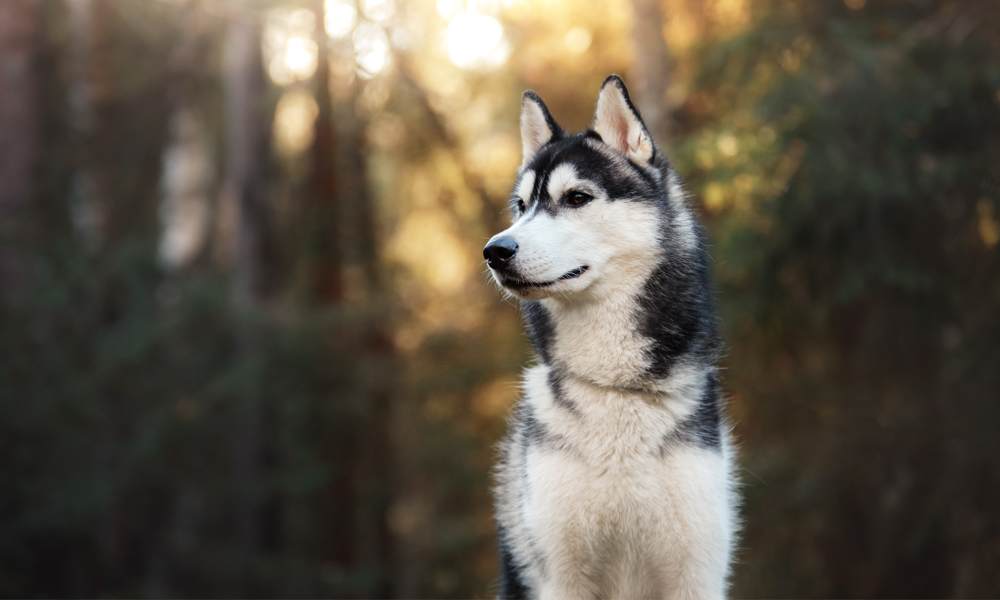
Source: canva.om
This dog tends to be destructive and will tear apart your house and yard if you let them. The better trained the dog is, the better behaved it will be. They’re friendly and loving but do not make good watchdogs – they’re too eager to make friends!
On average, Huskies live between 12 and 15 years. Some health concerns with this breed are hip and elbow dysplasia, hypothyroidism, and eye diseases, including cataracts, corneal dystrophy, and progressive retinal atrophy.
10. Chow Chow
The Chow Chow can weigh as much as 70 pounds and its large head and mane of fiery hair sure give it a large presence. This large breed dog is graceful, loyal, and devoted to its master but doesn’t like to be fussed over. Its independent streak is a perfect match for some dog lovers who don’t want a Velco dog or one that they need to constantly entertain. A Chow Chow makes a quiet, attentive companion.
Chow Chows respond to training best when they respect their owner. A Chow Chow’s perfect match is a person who can let the dog know that it’s not in charge while still respecting its independence.
A healthy Chow Chow has a lifespan of between 12 and 15 years. This is an exceptionally healthy breed but they are prone to hip dysplasia and entropion, a condition where the eyelid rolls inward and irritates the eye itself.
How to Make Sure You Choose a Healthy Dog
The best way to ensure your dog is as healthy as possible is to only buy from a reputable breeder. You should be able to meet at least one of the dog’s parents, usually the mother, and receive health clearances. Good breeders know the diseases and traits to look for in dogs and breed to make sure that the puppies have the best shot at having good temperaments and long, healthy lives.
Source of Featured Image: canva.com
I grew up in a household that was filled with animals. I believe that my fate as a dog-loving person was sealed in early childhood since my parents owned several dogs of varying sizes and breeds. There was no choice but to take care of and learn about dog habits and the best animal care practices — otherwise, I’d be clueless about how to go about the creatures I was surrounded by day and night.
As a life-long puppy lover, I know a thing or two about dogs and how to go about caring for them in the best way possible. Although I’m not a professionally trained dog behaviorist, trainer, or veterinarian, all of my knowledge and experience with canines comes from a place of love and a deep-rooted passion for dogs and animals in general.
Seeing as dogs kept me company throughout every stage of my life, I decided to follow a different path in my academic life and obtained a Bachelor’s and Master’s degrees in Marketing Management and Digital Advertising, which ultimately allowed me to combine my professional training and personal experience by creating the ultimate dog lover’s resource website! Along with my husband, Dave, I run MySweetPuppy for like-minded dog lovers who want to have a single, clear, and reliable information source about anything and everything related to dogs and their well-being.

